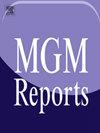A study of Iraqi patients with homocysteine remethylation disorders in a tertiary pediatric centre
IF 1.8
4区 医学
Q3 GENETICS & HEREDITY
引用次数: 0
Abstract
Background
Hyperhomocysteinemia is a group of inherited homocysteine metabolism disorders characterised by elevated blood homocysteine levels (total homocysteine >15 μM). Homocystinuria is classified into two main homocysteine metabolism disorders. Classical Homocystinuria is caused by a deficiency of the pyridoxine-dependent enzyme cystathionine beta-synthase in the trans‑sulfuration pathway. Non-classical Homocystinuria is a group of disorders affecting the interconversion of methionine to homocysteine through the re-methylation pathway.
Aim
This study aims to describe the clinical, biochemical, and genetic profiles of patients with re-methylation disorders.
Patients and methods
A cohort study was conducted at the metabolic clinic of Children Welfare Teaching Hospital in Baghdad from the 1st of December 2021 to the 1st of December 2022. The study included fifteen patients who met the following criteria: (1) elevated serum homocysteine levels (>15 μmol/L); (2) low or normal blood methionine levels (12–40 μmol/L). Results: fourteen MTHFR patients underwent statistical analysis, and one CblC patient was assessed separately. MTHFR patients comprised nine females and five males. The mean age at presentation was 7.1 years ±4.5, ranging from 1 to 16 years. Consanguineous marriages were reported in 13 patients. A family history of a similar disorder was documented in 73 % of cases. Among the families, four had two affected siblings. The two main reported clinical manifestations were gait disturbance (10/14, 71.4 %) and cognitive impairment/intellectual disability (6/14, 42.8 %). Brain MRI was conducted for all studied patients, with leukodystrophy being the most common finding (8/14, 57.1 %). Molecular testing revealed variants in MTHFR in 14 patients, and MMACHC in one patient.
Conclusion
According to this study, individuals with homocysteine re-methylation disorders can manifest symptomatology such as neuroregression, psychomotor delay, and whiter matter changes earlier than anticipated. And these disorders are amenable to treatment. Genetic testing is crucial in identifying the specific mutation type and guiding definitive treatment.
伊拉克同型半胱氨酸再甲基化障碍患者在三级儿科中心的研究
高同型半胱氨酸血症是一组遗传性同型半胱氨酸代谢疾病,其特征是血液中同型半胱氨酸水平升高(总同型半胱氨酸水平>;15 μM)。同型半胱氨酸尿分为两种主要的同型半胱氨酸代谢紊乱。经典的同型半胱氨酸尿是由反硫途径中吡哆醇依赖的酶-胱硫氨酸-合成酶的缺乏引起的。非经典同型半胱氨酸尿是一组通过重甲基化途径影响蛋氨酸向同型半胱氨酸相互转化的疾病。目的本研究旨在描述重甲基化障碍患者的临床、生化和遗传特征。患者与方法于2021年12月1日至2022年12月1日在巴格达儿童福利教学医院代谢门诊进行队列研究。本研究纳入了15例符合以下标准的患者:(1)血清同型半胱氨酸水平升高(15 μmol/L);(2)血中蛋氨酸水平低或正常(12 ~ 40 μmol/L)。结果:14例MTHFR患者进行统计分析,1例CblC患者单独评估。MTHFR患者包括9名女性和5名男性。平均发病年龄7.1岁±4.5岁,年龄范围1 ~ 16岁。13例患者报告近亲结婚。73%的病例有类似疾病的家族史。在这些家庭中,有四个家庭有两个患病的兄弟姐妹。两种主要临床表现为步态障碍(10/14,71.4%)和认知障碍/智力障碍(6/14,42.8%)。对所有研究的患者进行脑MRI检查,最常见的发现是脑白质营养不良(8/14,57.1%)。分子检测显示14例患者MTHFR变异,1例患者MMACHC变异。结论同型半胱氨酸再甲基化障碍患者可比预期更早出现神经退化、精神运动延迟和白质改变等症状。这些疾病是可以治疗的。基因检测在确定特定突变类型和指导最终治疗方面至关重要。
本文章由计算机程序翻译,如有差异,请以英文原文为准。
求助全文
约1分钟内获得全文
求助全文
来源期刊

Molecular Genetics and Metabolism Reports
Biochemistry, Genetics and Molecular Biology-Endocrinology
CiteScore
4.00
自引率
5.30%
发文量
105
审稿时长
33 days
期刊介绍:
Molecular Genetics and Metabolism Reports is an open access journal that publishes molecular and metabolic reports describing investigations that use the tools of biochemistry and molecular biology for studies of normal and diseased states. In addition to original research articles, sequence reports, brief communication reports and letters to the editor are considered.
 求助内容:
求助内容: 应助结果提醒方式:
应助结果提醒方式:


